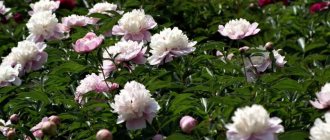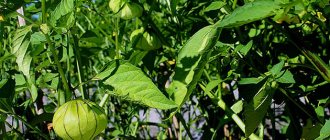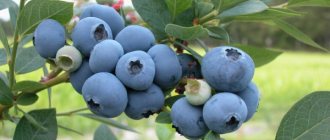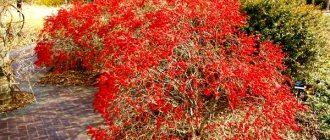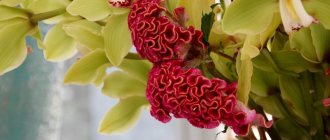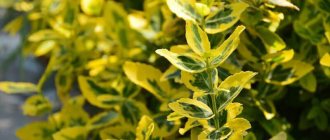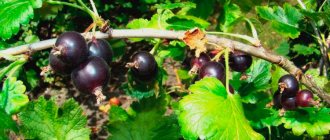Growing sea buckthorn
Sea buckthorn is a multi-stemmed deciduous shrub, usually 1–3 m high. Sea buckthorn is a medicinal plant. Growing it in your garden is not difficult at all. If you create the right conditions, she will delight you with healthy and tasty fruits.
Many people fail to grow sea buckthorn because the tree suddenly begins to die. To prevent this from happening, it is important to know that the roots of sea buckthorn are in the top layer of soil and go far to the sides of the tree, so digging up the ground can easily injure them.
Choosing a landing site
Planting a sea buckthorn seedling
Sea buckthorn is a very light-loving and moisture-loving plant, so the planting site should be sunny. In the shade it will grow and bear fruit worse.
The tree should be planted at the edge of the plot, away from the garden. To avoid damaging the sea buckthorn root system when loosening the bed. A damaged root will cause wild growth to grow. You can loosen the top layer of soil, no more than 10 cm deep. Along with loosening, humus and mineral fertilizers are added.
Altai - 0.7 g
The shrub plant can be grown in almost any corner of the country. Sea buckthorn " Altai " is distinguished by its excellent taste, ease of care and high yield - the fruits are oval, weighing 0.7-0.8 g. From one bush you can get up to 15 kg. harvest.
The pulp is fleshy and sweet in taste - according to those who tasted the culture, this is the only sea buckthorn variety that received 5 out of 5 points. “Altai” sea buckthorn can withstand severe frosts and does not stop growing even at -45 degrees.
How to choose sea buckthorn seedlings
It is better to select and plant sea buckthorn seedlings in early spring. Then over the summer the tree will take root well and overwinter normally. Seedlings two years old are suitable for planting.
Selection of seedlings
- It is important to ensure that the seedlings are healthy and appropriate for the plant variety. The two-year-old seedling has a height of about 50 cm and a diameter of 10 mm, it also has 5–8 skeletal roots, 25 cm long.
- The bark adheres tightly to the wood, has a healthy appearance, is not wrinkled or scratched.
To avoid tree diseases, you should not plant raspberries, strawberries, or where stone fruit trees grew: apple trees, pears, cherries, apricots.
It is better to have 2-3 female trees and one male tree on the site for pollination.
Openwork – 1 g
Sea buckthorn with a very interesting name is very popular among gardeners. The crop does not have thorns on its branches; in addition, the “ Azhurnaya ” sea buckthorn bears fruit abundantly.
This variety can withstand sudden temperature changes, it is easy to care for and is not demanding on growing conditions. Gardeners love to plant this perennial plant not only to obtain a harvest, but also to decorate the area.
The branches of the “Lacy” sea buckthorn bend beautifully in a semicircle and have a gray coating. The bright berries weigh approximately 1-1.2 g and ripen in late summer - mid/late August.
How to distinguish male and female trees
Sea buckthorn buds are blooming
Sea buckthorn is a dioecious tree; it is divided into male (staminate) and female (pistillate) flowers. The male plant does not produce fruit, it serves for pollination. One tree is enough for 5–7 female seedlings. Female sea buckthorn bears fruit. Without male sea buckthorn there will be no harvest. Trees need to be planted nearby, since pollination occurs with the help of wind.
It is difficult to distinguish these plants, especially at an early age. But there is a difference:
- The female plant has small double buds. Male specimens have larger buds covered with 3–5 scales.
- Male seedlings are larger.
- The leaves have different shapes and colors. On female sea buckthorn the leaves are green, male leaves are bluish and have a larger bloom.
Varieties
Sea buckthorn
Depending on the area of cultivation and personal wishes, the most suitable variety of sea buckthorn is selected. The most popular ones are the following.
Sea buckthorn varieties
The largest fruited varieties
A berry growing in the wild weighs about 0.2-0.3 grams; domesticated sea buckthorn has an average weight of 0.4-0.5 grams. Large-fruited fruits bear almost twice as much fruit - 0.7-1.5 grams. Among them are especially distinguished: Augustine, Essel, Openwork, Elizaveta, Zlata and Aurelia.
The sweetest varieties of sea buckthorn
Each variety has its own specific taste, some are sweeter, others are more sour; the most dessert characteristics are: Lyubimaya, Altai, Zhemchuzhnitsa, Essel, Moskvichka and Vorobievskaya.
Red varieties
Unusual orange-red fruits, noticeably different from ordinary orange berries, have: sea buckthorn Ognivo, Jamovaya, Inya and Etna.
Jam
The best varieties near Moscow
Not every variety of sea buckthorn is able to adapt to the temperate continental climate of this region; the most suitable for this are: Lomonosovskaya, Aromatic, Botanical Lyubitelskaya, Botanical Aromatic, Excellent.
Suitable for the harsh climatic conditions of the Siberian regions are: Augustina, Chechek, Zhemchuzhnitsa, Tenga, Elizaveta, Jamovaya, Orange.
The most productive are considered to be: Pepper hybrid, Moscow pineapple, Gift to the garden.
Thornless varieties of sea buckthorn: Altai, Solnechnaya.
Frost-resistant
Almost all varieties of sea buckthorn are characterized by high winter hardiness and can easily tolerate the harsh climate of Siberia, but still the following varieties stand out with the best indicators: Golden Cob, Trofimovskaya, Botanicheskaya Lyubitelskaya, Dar Katuni.
Male varieties of sea buckthorn
Aley
You can’t do without a pollinator variety:
- The gnome is a male cultivator, characterized by high winter hardiness and resistance to disease. Low growing plant with large dark green foliage.
- Alei is a powerful bush with a lush crown that blooms profusely and for a long time.
The most useful: Pepper, Zhivko, Vitamin, are distinguished by a more concentrated composition of nutrients.
Care
Caring for this shrub is easy. It is important to loosen the soil, water and feed the plant, and remove dried shoots. And then the sea buckthorn will bear fruit for about 12 years. After reaching the time when the tree stops bearing fruit, you can cut it down to the stump, this will stimulate the growth of new shoots, which in the future will bear fruit again.
Watering
Sea buckthorn loves watering, especially in hot weather. When picking berries, we recommend watering the sea buckthorn well and rinsing the berries on the branches in one go.
Top dressing
You need to feed 4 times a season:
- The first time this is done is in the spring.
- the second time during flowering, this is done with a solution of potassium humate.
- the remaining two feedings are carried out after flowering, with an interval of 20 days, for this they use Effecton.
Trimming
An important condition for care is trimming the top. This promotes good crown development. You need to prune before the buds open to remove unnecessary, damaged branches and root shoots. This can be done during harvest. The tree can grow up to 6 meters; for convenient harvesting, it is important to regularly trim the tops. This is done with a sharp garden knife or pruning shears.
For preventive purposes, three-year-old branches are pruned.
Elizabeth - 0.9 g
Sea buckthorn “ Elizabeth ” is a variety characterized by high yield, strong immunity and good taste. It has become widespread due to its decorative functions - the leaves of sea buckthorn are elongated, the crown of the shrub is oval, the berries weigh 0.9-1 g, reach 1 cm in length and are shaped like a cylinder. Since the pulp contains 10% sugar, the berries taste sweet.
“Elizabeth” is easy to care for and resistant to low temperatures. This variety gives a large harvest - about 12 kg can be harvested from one bush. fruits that ripen in the 3rd decade of August. Sea buckthorn "Elizabeth" is considered a late variety.
Berry picking
Picking sea buckthorn berries
Varietal sea buckthorn produces a high yield in favorable conditions. The berries grow densely on the thorny branches of the tree, which requires a lot of time and patience when picking the fruit. Harvest at the end of August. But if you make juice from the berries, the harvest is postponed until the beginning of September. Do not tighten too much, the berries become soft and burst.
Options for collecting sea buckthorn
There are several known ideas for harvesting sea buckthorn :
- The traditional method is to tear off each berry, but this is very long and tedious.
- They use different devices, for example, a stick with a hook. They are used to remove berries from the branch and they fall into the prepared container.
- You can cut off the branches along with the fruits and freeze them. Frozen berries are easier to remove from the branch. This method is suitable in case of further freezing of fruits.
- If you make juice from sea buckthorn, it is better to use the following method. Wash your hands well, or better yet, put on culinary gloves, and squeeze the juice directly onto the branch. You need to start from the base and lead to the end of the branch. The finished juice will fall into the placed basin. You can squeeze up to 5 liters of nectar in an hour.
- There are also many devices for picking berries. You can take a wooden handle and wire, make a loop from the wire. To pick a berry you need to: put a loop on the fruit and sharply cut off the foot, the berries will fall into the basin.
Recommendations for collecting sea buckthorn
- The berries should be cut from the crown to the bottom of the branch.
- It is also important to wear gloves to avoid scratches from thorns and skin irritation. To avoid ruining your clothes, you can use an apron, because sea buckthorn juice cannot be washed off.
- There is no need to wash the berries, otherwise some of the juice will be lost. Before collecting, you can rinse them directly on the bush.
- It is better to collect in enamel dishes.
- Process on the same day as harvest.
Reproduction
There are many known ways to propagate sea buckthorn:
- The easiest way to propagate is by seeds ; they are sown in the fall. Shoots appear in a month. This method is used when breeding new varieties. Since such propagation produces male plants, they are used for decorative purposes or for grafting other varieties.
- Propagation by root suckers is used when sea buckthorn is not grafted. In the spring, the offspring is separated from the mother plant, dropped in drops and watered well. When the root system has developed well, it can be transplanted to another place.
- For propagation by layering, it is better to take annual shoots. The soil needs to be fertilized. After that, small furrows are made near the base of the bush, into which the young shoots are bent. The tops are pinched a little. When young shoots grow 12 cm, they are sprinkled with moist soil with humus. In the spring, the rooted cuttings are transplanted to a permanent place.
- When transplanted to a new place, sea buckthorn is propagated by dividing the bush . To do this, dig up a bush, remove old branches, leaving young ones. When dividing a bush, choose plants with a developed root system.
- For propagation by green cuttings, non-fruit-bearing plants are used. In this case, you will need a greenhouse or greenhouse. The cuttings should be 12 cm in size. The bottom two leaves are removed, the cuttings are immersed in the rooting solution for 12–15 hours. Then they are planted in a greenhouse with prepared soil. To do this, fertile soil is mixed with peat and sand in a ratio of 1:3. It is important to monitor the temperature and water the cuttings regularly; after a few weeks, adventitious roots will appear. And after a month, gradually accustoming the plant to the outside air, the film can be removed.
- The most accessible method is propagation by lignified cuttings . They are prepared in November and stored in the basement. In the spring, they are cut into 20 cm pieces, soaked in water for several days, and then in a rooting agent solution for a day. After which the buds and root makings appear. Cuttings are planted in prepared soil, watered abundantly and mulched with humus. Within a year, healthy seedlings are transplanted to a permanent location.
Diseases and pests
Most often, the sea buckthorn tree gets sick from changes in temperature and humidity. The most serious disease is verticillium wilt . This is an incurable disease in which the berries shrivel and dry out. Affected branches should be trimmed and discarded. If this disease appears again next year, the tree must be disposed of.
The following pests are known:
- Sea buckthorn moth . The caterpillars of these parasites crawl inside the kidney and eat away the core. Spraying with Chlorophos will help get rid of pests. This can be done before the buds open.
- The same method is used in the fight against sea buckthorn fly . It can destroy the crop.
- Sea buckthorn aphids infect tree leaves. They quickly turn yellow and fall off. A decoction of onion or garlic peels or 10% Karbofos will help get rid of parasites.
Gift of Katun – 0.7 g
Dar Katuni from other varieties by its slightly thorny shoots. The average weight of the berry is 0.5-0.7 g. Many gardeners value this variety for its abundant annual fruiting, which occurs already in the 3rd year.
In appearance, the shrub resembles a coniferous tree; it can grow up to 3 m in length. You can get up to 17 kg from one tree. fruits, which is certainly a huge plus. Juicy fruits with notes of pineapple contain vitamin C, which is so necessary for humans.
After the first frost, the taste of the berries only improves. Often, “Dar Katun” is used as a hedge, because the variety has a decorative appearance.
Harvesting berries
Sea buckthorn fruits are very rich in vitamins and biologically active substances. Sea buckthorn is very useful and has medicinal properties.
Fresh fruits can simply be frozen or ground with sugar. You can make juice from the berries, make jam or jam. You definitely need to stock up on sea buckthorn oil for the winter. This healing agent is known for its antibacterial and anti-inflammatory properties.
By growing sea buckthorn on your property, you can provide your entire family with vitamins all year round. By consuming these berries every day, the body will receive many beneficial substances.
Trofimovskaya - 0.7 g
" Trofimovskaya " sea buckthorn was obtained in the Botanical Garden of Moscow State University. M.V. Lomonosov, and was included in the register in 1993 for the North-Western and Volga-Vyatka regions. Sea buckthorn "Trofimovskaya" has oval fruits, large in size - 0.7 g, their use is universal. The shrub can grow up to 4-5 m.
This variety has a medium-late ripening period, the berries are sweet and sour, and taste like pineapple. It can withstand harsh winters, so sea buckthorn can be planted in any region.
